ASTRID FITZGERALD
C O S M I C M E A S U R E S
November 11 - December 8, 2000
MUROFF KOTLER VISUAL ARTS Gallery
SUNY At Ulster, Stone Ridge, New York 12484 Gallery Hours: M-F, 11 to 3 or call 845 687-5113 for appointment |
|
ASTRID FITZGERALD
C O S M I C M E A S U R E S
November 11 - December 8, 2000
MUROFF KOTLER VISUAL ARTS Gallery
SUNY At Ulster, Stone Ridge, New York 12484 Gallery Hours: M-F, 11 to 3 or call 845 687-5113 for appointment |
|
ARTIST'S STATEMENT
I call these pieces Cosmic Measures. The geometry emerges naturally from the mind and nature and reflects the way we perceive the mysteries of time and space, creating windows on the soul of the world.
All of the work has a formal basis in the Golden Mean Proportion with its inherent harmony and unity, which provide me with both a foundation and infinite possibilities and a sense of perpetual play.
On the surface, the constructions explore traditional modernist aesthetic concerns, but they also aim to go beyond by intimating an underlying order of the universe and exploring - by means of illusionism - the insubstantiality of material and surface.
The works on paper are inspired by ancient Eastern texts, which describe the qualities of the Creative Principle with their contemporary correlations in the Unified Field and quantum physics. Qualities expressed in words such as Infinity, Timelessness, Pure Consciousness and Oneness are in reality inexpressible and insubstantial. Reflection upon these qualities nevertheless activates the creative imagination and gives rise to perceptions in the mind which eventually find expression in the creative act.
I believe that the more universal, the more primal the thought and form, the more powerfully it will speak to the harmony within. - Astrid Fitzgerald
COSMIC MEASURES AT THE MUROFF KOTLER VISUAL ARTS GALLERY
INSTALLATION SHOTS


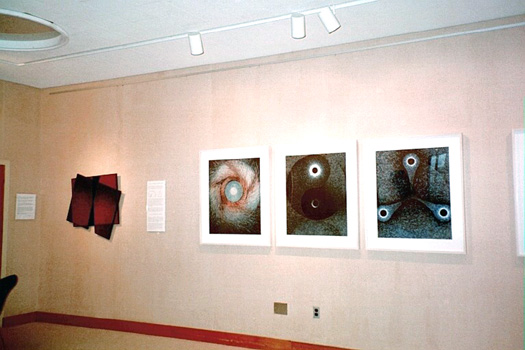
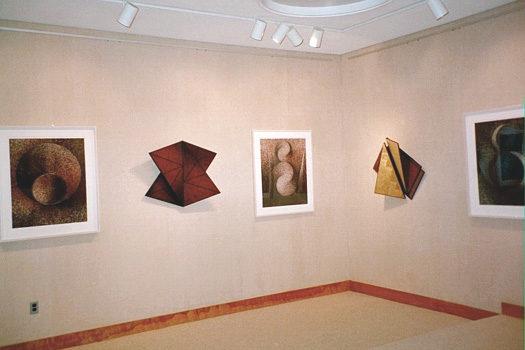
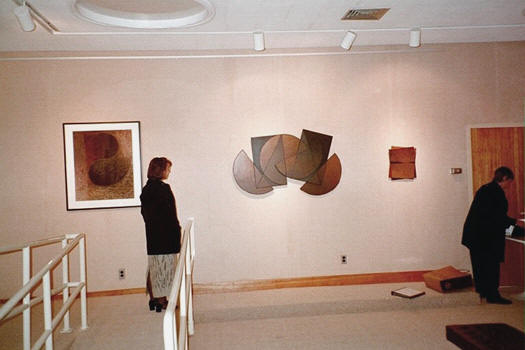
Opening Reception


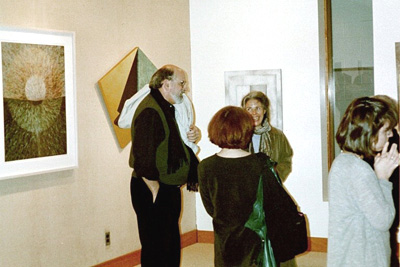
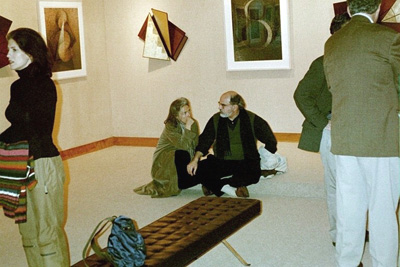
EXHIBITION REVIEW
WOODSTOCKTIMES Vol. 27, No.46; November 16, 2000
Probing the mysteries
ASTRID FITZGERALD: COSMIC MEASURES
MUROFF KOTLER GALLERY, UCCC, STONE RIDGE, NY
Astrid Fitzgerald has a studio in New York City and one in Kerhonkson, where the majority of the work in her present show, Cosmic Measures, was made. The work can be seen at the Muroff Kotler Visual Arts Gallery at Ulster County Community College in Stone Ridge.
Fitzgerald was born in Switzerland, immigrating to the United States in 1961. She attended the Pratt Graphics Center and the Fashion Institute of Technology in New York City, as well as some years earlier studying at the Arts Students League.
For almost 20 years Fitzgerald has taken as a starting point for her work the
concept of the Golden Mean, a system of geometric proportion mathematically
formulated since Pythagorean times. This, plus an abiding interest in Quantum
physics and the unified field, are the scientific tethers for her work.
One of the major innovators of the modern art movement, Wassily Kandinsky (1866-l944), has been an inspirational influence for Fitzgerald. Intriguingly, it appears Kandinsky has helped direct Fitzgerald back through the Golden Section to the geometric mysteries revered by the ancients and replete within nature. Kandinsky, coming to prominence a few years before the Russian Revolution of 1917, for a while was part of it, running art schools that extolled geometric design and abstraction (this before the Stalinist crackdown that excluded all art that didn't follow the socialist realist guidelines) in the artistic intellectual exodus that followed. Kandinsky had a profound influence upon Gropius and the Bauhaus School, which in turn gave birth to the "Basic Design" course that became the official backbone of art school education in both Europe and America and is a heritage to this day. Around this time, Kandinsky's book, Concerning The Spiritual in Art, passionately acclaimed abstract art as the way to the "soul" of art and expression. Indeed it could be argued that although Cubism, manifesting around the same time in Paris, irrevocably shattered the smooth-as-glass Victorian art picture plane already torqued by the Impressionists and Fauves, it was Abstractionism out of Russia that had a stronger cultural effect, fertilizing the ascendancy of American abstract art through the '50s, leading to the feet-on-the-ground, painted-from-the-hip, libidinal splattered gems of Jackson Pollock.
Fitzgerald, although having a quieter, less stormy, more rational take on the Golden Mean, comes out of this modernist tradition as well as hearkening back to the ancients by investing the incontrovertible yet mysterious measurements (in her works on paper) with a stippled, layered juxtaposition of pastels reminiscent of Seurat. Points of light flare and darken at the perimeters of the timeless, circular forms, traces hinting of yin and yang, stillness, infinity, potential....
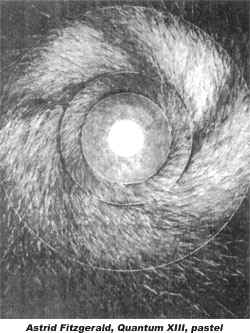 On the two side walls of the gallery are a series of constructions made of wood.
One is sawn into triadic rectangles, upon which are incised the circle and the
triangle; some of these shapes are gold-leafed, glittering drunk with light
against somber purples and umbers, emotive tones recalling the artist's visit to
Knossos, Greece. In another construction the dying embers of a Mediterranean sun
set, drowning red, speckled with the coalescing black of the falling night.
Traces of an ancient Greece flicker in the undulating geometry. Those students
at present paralyzed in the grip of their geometry classes might get a jolt of
vision and energy from Fitzgerald's interpretations.
On the two side walls of the gallery are a series of constructions made of wood.
One is sawn into triadic rectangles, upon which are incised the circle and the
triangle; some of these shapes are gold-leafed, glittering drunk with light
against somber purples and umbers, emotive tones recalling the artist's visit to
Knossos, Greece. In another construction the dying embers of a Mediterranean sun
set, drowning red, speckled with the coalescing black of the falling night.
Traces of an ancient Greece flicker in the undulating geometry. Those students
at present paralyzed in the grip of their geometry classes might get a jolt of
vision and energy from Fitzgerald's interpretations.
On the wall to your left facing you as you leave the room are three works, all untitled, of casein on masonite, basically black-and-white, one with a little red ocher cast like an oxide rainbow against the incised geometry. These images are less circular, more edgy. Betwixt black and white we wander tonally in the grays, Fitzgerald appears to be risking her hold on the sacred. Is there a hint of the profane? A scratch, a jag, an imperfection? Perhaps it's in here, the space between concepts, that possibility may lie. At times the artist seems to be talking at the work. In these pieces, the art seems to be defiantly and definitely talking back, which is good to hear.
Astrid Fitzgerald also has her book, An Artist's Book of Inspiration: A Collection of Thoughts on Art, Artists and Creativity, for perusal at the exhibition. Fitzgerald's work can also be viewed on line at www.astridFitzgerald.com.
Fitzgerald has taken us on a journey. Her work, though formally modern enough for a few gallery visiting students "not to get," is actually rife with natural law. Her work is an echo of the sun setting over Stone Ridge as we leave, of the make-up of the surrounding trees, of our own spiraling D.N.A.
Perhaps, what by some is seen as unrelated cerebral, conceptual abstraction is really at home and rooted in the natural world - the falling autumn seeds curving, whirling in the wind, rustling off our orbed planet. Fitzgerald helps return us to the quiet, the balance, the harmony within all. ++ - Adrian Frost